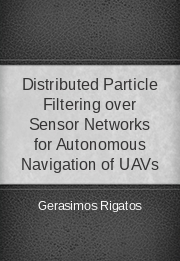Distributed Particle Filtering over Sensor Networks for Autonomous Navigation of UAVs
- / Home
- / Technology Books /

Author: Gerasimos Rigatos
Downloads: 33
Visits: 1
Pages: 37
Published: 11 years agoRating: Rated: 0 times Rate It
- 1 star
- 2 stars
- 3 stars
- 4 stars
- 5 stars
Book Description
The paper has examined the problem of localization and autonomous navigation of a multiUAV system based on distributed filtering over sensor networks. Particular emphasis was paid to distributed particle filtering since this decentralized state estimation approach is not constrained by the assumption of noise Gaussian distribution. It was considered that m UAV (helicopter) models are monitored by n different ground stations. The overall concept was that at each monitoring station a filter should be used to track each UAV by fusing measurements which are provided by various UAV sensors, while by fusing the state estimates from the distributed local filters an aggregate state estimate for each UAV should be obtained. The paper proposed first the Extended Information Filter (EIF) and the Unscented Information Filter (UIF) as possible approaches for fusing the state estimates obtained by the local monitoring stations, under...

